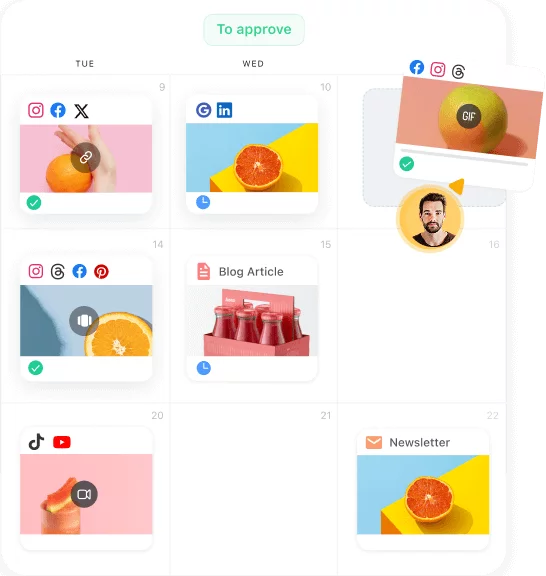Most of us have an attention span of 8 seconds – the only time social media managers get to engage customers with their content marketing.
From the small to the giant, each one of them is trying to come up with content that captures user attention within the short time frame.
With large amounts of resources pumped into social media campaigns, and with stakes higher than ever, managers have gone through many sleepless nights trying to make their campaign a runaway success. Unfortunately, for some, an unsuccessful social media campaign isn’t a nightmare – it’s a reality.
Content plays a big role in the success or failure of a social media campaign. Speaking with marketers, 88% of them mentioned they create custom visuals 50% of the time when it comes to social media content. While some reap the benefits of good content, many lose big because of their mistakes. The inability to recognize content flaws leads to weak campaigns.Your efforts to understand the gaps in your social media content can empower you to come up with a robust and effective content strategy.
To avoid content paralysis – here are five content marketing mistakes you should be careful not to make:
Using Content for Hardcore Selling
Social media managers have a knack for using content for selling rather than engaging. You don’t ask a girl to marry you on the first date, in some rare case you might get a ‘Yes’ but in most, it’s a very clear ‘No’.
The aim of your social media content should be to engage users and create a special relationship with them. Once you have established that link, then you can go out and sell. That means, the initial objective of your content should not be selling – it should be building trust.
A simple way of building a rapport with customers is by creating content that encourages a two-way dialogue. Say for example, instead of giving a list of features, explain how your brand can help make life easier.
Emulating Someone’s Content
In a situation of desperation, social media managers end up resorting to the old cliche of using tried and tested marketing tactics. In trying to execute a successful strategy, most marketers duplicate content marketing of other successful brands.
Content applied without understanding how it can help in achieving social media objectives is a grave mistake. One size doesn’t fit all, and that’s why you need to come up with content that speaks about ‘Your brand’ to ‘Your audience’.
Say, you are a newbie jewelry brand trying to find a place in a crowded social media world. Instead of creating an initial rapport, you take references from already established brands and create content that talks about your ‘Brand legacy’.
Expecting users to have an emotional connection with your brand is fool hearted because unlike you, the other brands have been in the market for a long time and that’s why users trust them.
Being Emotional About Your Content
In most cases, being emotional about something is always great, but when it comes to your social media content, you cannot afford to have sentimental values. It makes it impossible for content managers to open their eyes to criticism.
Many managers, out of their stubbornness, ignore what customers are saying – this invariably adds to the misery of their social media marketing. Reworking and constantly taking inputs from your users is part and parcel of the job, an over obsessive manager would not be able to understand this.
By using various social media monitoring tools, understand how users are engaging with your content. Use the customer feedback data to rework on your content and improve the viability of your social media campaigns. Managers need to be more thick-skinned and be better prepared when their content backfires.
When you come up with a content piece, collaborate with team members and get a feedback from them. Get new perspectives, based on which, you are able to prepare better arguments. Give your opinion in a clear fashion, users might not like your content, but they will respect you for sticking to your guns.
Undervaluing Your Call-to-Action
When it comes to social media content, managers tend to fail at communicating what they expect the users to do. “A lack of a clear CTA confuses users on how they should act on your content”- state professionals from essay writer service. Ignoring your CTA at the expense of focusing on creating layouts, writing, or formatting is a mistake that many managers make.
A CTA is not an add-on, it is the crux of everything that you do. Every aspect of your content needs to be created around your CTA, not the other way round. In the glitz and glamor of layout and writing fancy headlines, don’t forget to lose sight of your actual goal. A great example is nonprofit digital marketing cases – and I’ve seen it happen. Publish content about a cause and leave the reader to decide what to do about it – it always hurt the CTR,
If you are not sure which kind of CTA would work for you, here are a few tips to remember:
- Before asking users to try your product, highlight the reasons they might need it.
- Offer an incentive to complete the call to action.
- Make your CTA big, so they don’t skip the attention of users.
- Use active word when designing your CTA copy, use words: Like, Buy, Register, Donate, Submit, Subscribe.
Winding up
These are few of the many blunders made by social media managers, which costs them dearly. To mend these mistakes is expensive and in most cases – impossible. The better way to go about is not allowing these mistakes to happen in the first place.
By having a proactive approach, managers can improve the workings of their social media campaigns. Documenting your social media content can perhaps be one of the best ways to avoid these mistakes. Conventionally, a social media content document should include – overall goals, how to use content at each stage of marketing, how to amplify the content outreach and an editorial board.
Planning ahead is one of the best ways of keeping track of the performance of your social media content, It reduces your chances of making any wrong moves. Ultimately, mistakes happen only if you let them.
This article was submitted by Niraj who is the founder of Hiver (hiverhq.com), an app that turns Gmail into a powerful customer support and collaboration tool. Niraj can be reached on Twitter @nirajr
Dropped out of college, moved to another country with 2 of my friends and built Planable (Techstars London ’17), social media collaboration platform, at 19 y. o. Forbes 30 under 30






